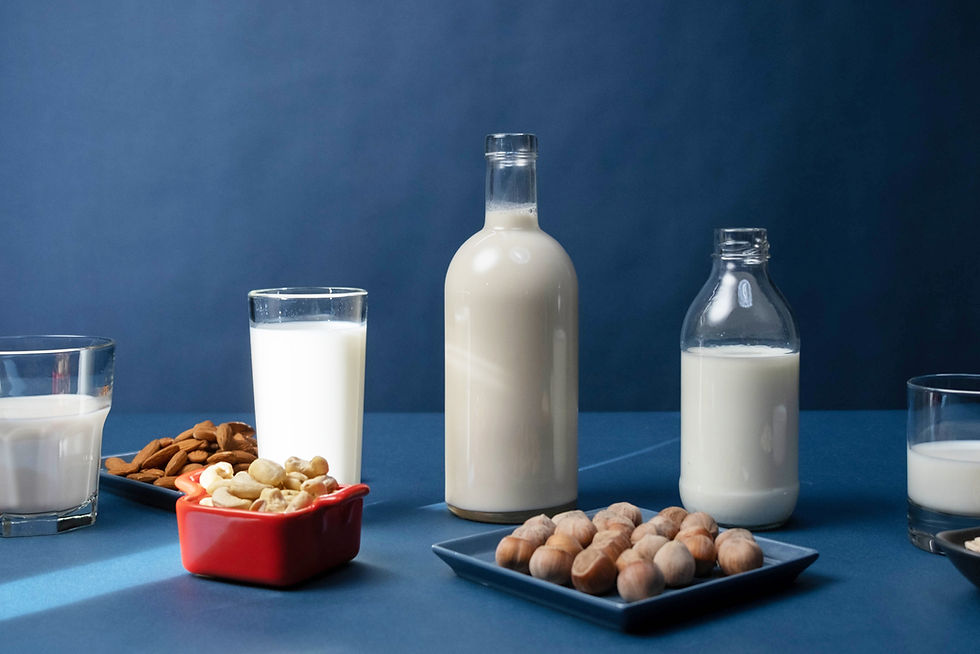How to Get The Nutrients That You Need on a Vegan Diet
- AfroVegan Society
- Feb 24, 2021
- 4 min read
Updated: Jan 24, 2024
By: Brittany Walker-Craig, M.S. | Plant-Based Nutritionist

You probably have been hearing about how healthy it is to transition to being vegan, but may also hear questions like:
“How do you get protein if you are not eating meat?”
“Where do you get your Vitamin B12 from?”
“So what exactly do you eat, grass?”
“How can you eat anything that is not ‘real’ cheese?”
“Milk is supposed to come from cows so how do you get dairy?”
“How are you supposed to make grandma’s famous <insert dish> without meat, animal fat or dairy?”
In all actuality, you are able to receive an abundance of protein from many whole plant food items. There are plant-based alternatives to receiving Vitamin B12 and NO - vegans do not just eat grass although, green leafy vegetables are delicious! Non-dairy cheese options are primarily nut-based, which provides more nutrients than cheese made from cow's milk. Cows suffer unnecessarily while being milked against their will for human consumption, all the while, nuts, oats and seeds all make yummy & healthier substitutes. As for your grandma’s famous dish, you can recreate anything by making the proper dietary modifications that not only satisfy your taste buds, but also provide you with the nutrients needed to achieve optimal health. Let’s deep dive into how you can get the nutrients that you need on a vegan diet!

We need both macronutrients and micronutrients to sustain a healthy lifestyle. Macronutrients are needed in large amounts such as protein for cell/tissue development, carbohydrates for energy, brain function & healthy red blood cells, fats for hormone regulation and water for fluid balance. Micronutrients are needed in smaller increments such as vitamins and minerals. It is vital to eat a variety of food items from each food group and in different colors, as each piece of plant food provides different nutritional properties for the body. There are resources such as the Dietary Guidelines for Americans (DGAs) or MyPlate that aid in determining the best options to consume in order to remain healthy based on case studies and reports.
According to the DGAs (2021) for 2020-2025, it is recommended to eat:
Vegetables of all types - dark green, red, orange, beans, peas, lentils, starchy and other vegetables
Fruits, especially whole
Grains, at least 1/2 are whole grain
Dairy including fat-free/low-fat milk, yogurt, cheese, and/or lactose-free versions and fortified soy alternatives
Protein foods including lean meats, poultry, eggs, seafood, beans, peas, lentils, nuts, seeds & soy products
Oils including vegetable, nut & seafood oils
As a vegan, these recommendations are relatively easy because most of the items listed in the DGAs are plant-based with the exception of meat and dairy. Both the DGAs and MyPlate recommend to decrease added sugars, added sodium, alcohol and any saturated or trans fat from your diet. Eliminating these items will decrease your risk of developing the chronic illnesses that are the leading causes of death in the US such as heart disease, cancer, diabetes, Alzheimer’s, and more. Here is an example of what you can intake as a vegan to gain all of the nutrients that you need in a day, according to MyPlate (2021) based on a 2,000 calorie diet:
2 cups of fruit
Try a mixture of berries, pineapple, kiwi or grapefruit. Enjoy for breakfast, as a snack, or incorporate a ¾ cup serving for each of your 3 meals!
2 ½ cups of vegetables
Kale, red bell peppers, carrots, spinach, squash or eggplant are some suggestions. Try incorporating up to 1 cup per meal. For breakfast, you can incorporate vegetables into your smoothie, potato hash or eggless omelet.
6 oz of grains
Quinoa, wild rice, brown rice, whole grain pasta or whole grain bread are great options. 2 oz at each meal will work well!
5 ½ oz of protein
Chickpeas, hemp seeds, lentils, beans, mushrooms, teff, tofu or tempeh are all great examples of plants rich in protein. Enjoy up to 2 oz per meal!
3 cups of vegan dairy options
Vegan milks and yogurts made from oats, hemp seeds, walnuts, almonds or coconuts are all super creamy and nutrient dense options. Try incorporating a 1 cup serving per meal!
Vitamin B12 and Vitamin D happen to be the 2 micronutrients that vegans struggle with consuming the most because these items are infused into animal and dairy products. It is not as hard as you think to get what you need as long as you are aware of your reputable resources. Examples of vegan sources of these nutrients include:
Vitamin B12: algae, seaweed (including sea moss), kombucha, cereals, tempeh, fortified plant milk, nutritional yeast, alternative meat substitutes
Vitamin D is a non-essential nutrient so you do not need food to acquire it and can sit in the sun for a minimum of 30 minutes and absorb the vitamin. Fortified soy & oat milk in addition to cereal will provide applicable amounts of the vitamin.
So what are you waiting for?! As you can see, it is not difficult to get the nutrients that you need on a vegan diet. It just takes commitment, time and the overall goal of wanting to live a healthier lifestyle in order to fulfill our purpose in this destiny.
Resources:
Home: Dietary Guidelines for Americans. (2021, January). Retrieved from https://www.dietaryguidelines.gov/
Your MyPlate Plan - 2000 Calories, Ages 14. (2021). Retrieved from
https://www.myplate.gov/myplate-plan/results/2000-calories-ages-14-plus
About the Author

Brittany Walker-Craig is a Plant-Based Nutritionist, Biology Professor and retired Chef who is an advocate for plant-based living! After reversing multiple health diagnosis and losing more than 80 pounds, I vowed to serve the Black community and educate individuals on how they can achieve optimal health by breaking generational curses, bad habits and traditional culture beliefs.















Comments